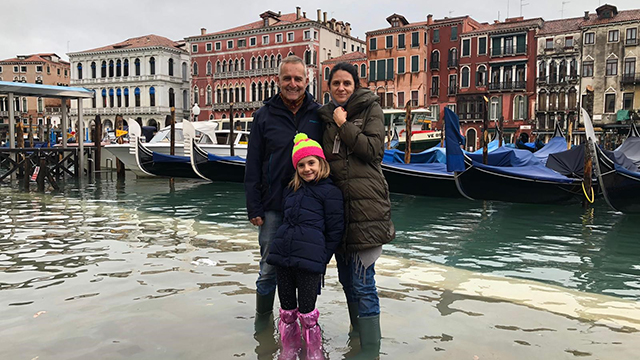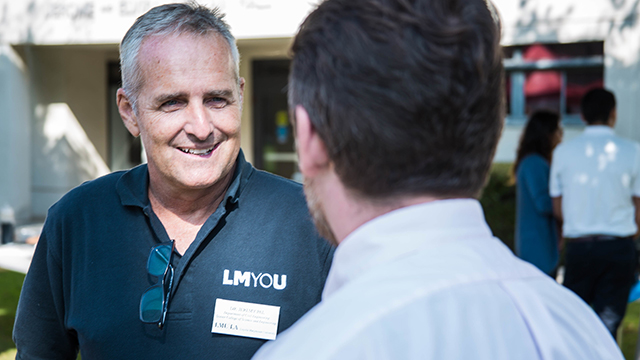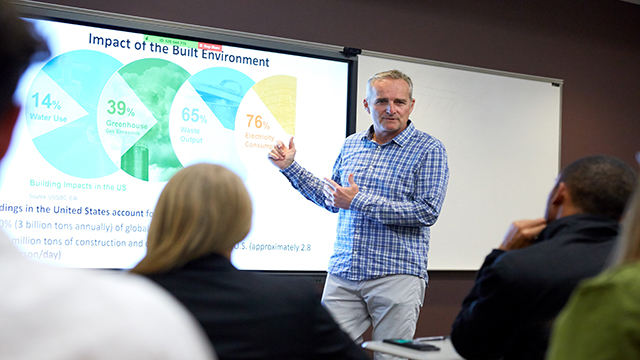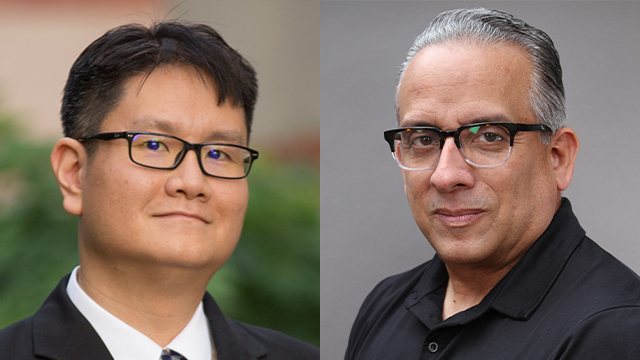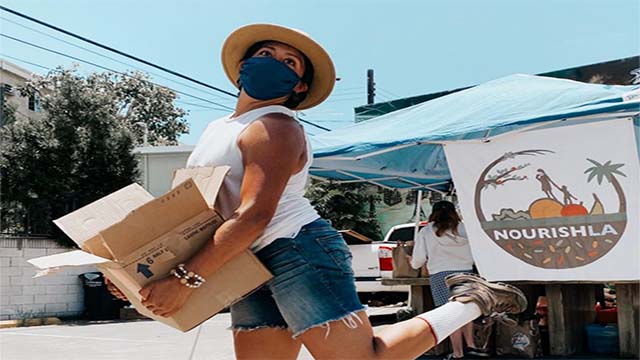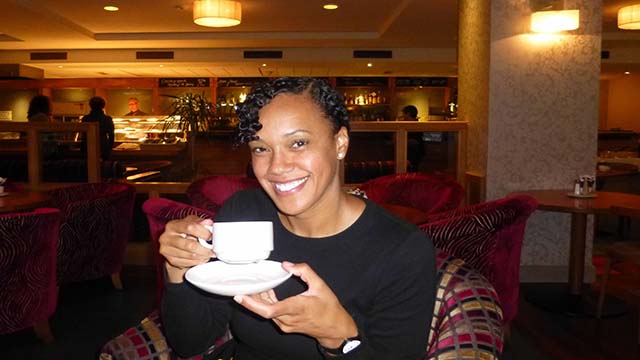
Dr. Jeremy Pal—scientist, professor and director of two graduate programs in civil engineering and environmental science at Loyola Marymount University (LMU)—is definitely one of Santa Monica College’s most distinguished alumni. But, catching up with Jeremy via Zoom in his Venice, Italy home—“from Venice to Venice,” he quips (his hometown is Venice, Calif.)—one immediately gets the sense that this is someone who’d much rather stay out of the limelight, and quietly do his work—which amounts, more or less, to saving the planet.
He is a Nobel Laureate (and will be quick to point out that he was part of a team of scientists—the Intergovernmental Panel on Climate Change (IPCC)—that shared the Nobel Peace Prize in 2007 with Al Gore, “for their efforts to build up and disseminate greater knowledge about man-made climate change, and to lay the foundations for the measures that are needed to counteract such change."). His scientific research—Jeremy focuses on the impacts of anthropogenic forcing, changes in our planet’s energy balance due to human economic activity—has taken him all over the world: Asia, Europe, the Middle East, and more. (You can read Jeremy’s bio here; he transferred from SMC to LMU for his bachelor’s degree, and went on to earn an MS and PhD in Environmental Engineering from MIT).
As familiar as this twist may sound by now, there was a time when Jeremy could not imagine the life he’s built, accomplished in a field he loves, and contributing to shifting the fate of our planet. Enter Santa Monica College, and a mother who told a young man who had no interest in college that he ought to give it a shot. He did. And the rest is history. SMC in Focus is pleased to present this interview with Dr. Jeremy Pal, distinguished alum and a testament to the transformational force that is SMC. (Our conversation has been edited for clarity and brevity):
SMC in Focus: What are you doing in Venice, Italy?
Jeremy Pal: Well, I am taking advantage of the pandemic, I guess. . . I had a sabbatical last
year and since my wife is from Italy, we decided to be closer to her family. While
I’ve resumed working at Loyola Marymount University now, I’m still in Venice remote
working and also consulting with a climate change center here, the Euro-Mediterranean Center on Climate Change (CMCC).
SMC in Focus: Not every distinguished alum acknowledges that they got their start at Santa Monica College. We’ve noticed in your official bio, and elsewhere, that you mention SMC, the fact that you earned an AA here. So take us back to that time. . . how did the college help set you on this path?
Jeremy Pal: We will have to go back even a little further—
SMC in Focus: Sure.
Jeremy Pal: My mother actually convinced me to go to college, and the only opportunity I had was SMC, or other community colleges because I wasn’t a particularly good high school student (I attended Lincoln Middle School, and then Santa Monica High School). I didn't have the opportunity to go to a university right away because my grades weren't high enough. I didn't really intend to do much at SMC other than show my mother that I wasn't set up to go to college. But a lot of the faculty there are truly invested in the students and the teaching at SMC is outstanding, arguably in contrast to many big-name four-year universities. The faculty are there for the benefit of the students more so than to fulfil research agendas. They were always available to talk to me if I needed their help.
An instructor named Eric Shargo enlightened me to many of the environmental problems going on in the world at the time. He was also a lifeguard in Santa Monica, and lectured about the contaminants in the water and the health problems that lifeguards were having, including cancer, because of the contaminants. It put me on a path to want to help solve environmental issues and help save the planet.
There was also my English teacher Gordon Dossett—English was my worst subject, and it might come across in this interview! — with whom I went on a study abroad program, to England. He gave a lot of liberty in some assignments to write about what we wanted to. I remember I wrote an essay about the reality of bear attacks in one and in another about climate change. So, my first exposure to climate change was actually in that class because Gordon said to do a literature review on a topic of my choice.
SMC in Focus: You attended SMC, and then onward to LMU and MIT. So it was not like an overnight shift, was it? What happened—did something happen—where you went, “Okay, I am college material.”
Jeremy Pal: There were a lot of factors. The path I was going down didn’t look too good. Back then, Venice (California) was a different place than it is now. I grew up there and saw a lot of friends going down a path that I was beginning to realize was not the best path for me. So, I needed an alternative to keep me from going down that path. I needed a passion, but I didn't really have one. I really attribute SMC with enabling me to find my passion.
That was largely due to the SMC faculty, but also the opportunities in the community college system—where you have the option of exploring a lot of different avenues, to not get stuck in one track.
SMC in Focus: That was 1990 when you were at Santa Monica College?
Jeremy Pal: From 1988 until 1991. Actually, my first semester there, I believe I was on academic probation . . . It took me three years to get my Associate’s.
SMC in Focus: Hard to believe, but . . .
Jeremy Pal: In fact, I think maybe Gordon [Dossett] gave me a D in his class. Maybe I got a C? He made me work hard for my grades. In England, I took Shakespearean literature from him. It was probably one of the hardest classes I've ever taken in my life. I got a B, and I really, really worked hard for that B. To this day, I feel very proud of that B because for me to actually do well in a literature class was a big accomplishment!
SMC in Focus: Remind us what you majored in at LMU, and take us from that moment to MIT and your early career leading up to being part of the team that won the 2007 Nobel Peace Prize.
Jeremy Pal: I went to the career center at SMC, [because] I wanted a job. My reason to get a degree was more for employment reasons I guess rather than for personal growth. Basically a computer program that I used at the career center said environmental engineering was a good field for me. My passion was really environmental science, but my understanding at the time was that I wouldn't have many job opportunities in environmental science. So, engineering was the track.
At LMU, I majored in civil engineering with an emphasis in environmental engineering. The faculty at LMU are also very invested in the success of the students, which is why I went back to work there. So, I sort of started my upward trend at SMC, stayed the course, and ended up graduating first in the engineering class at LMU. Then I went to MIT and got a master’s and a PhD in environmental engineering.
My first job was as a research scientist in Trieste, Italy, at an agency called the Abdus Salam International Centre for Theoretical Physics, which operates under UNESCO’s umbrella. I wasn't doing theoretical physics—but more of what I’d call applied physics. I was in the physics of weathering climate group—now called the earth system physics group. There, I worked under somebody who was very connected to and very high up in the climate change community. I was his right-hand man at the time. I guess because of those opportunities, I was invited to contribute to the IPCC (Intergovernmental Panel on Climate Change) which won the Nobel.
SMC in Focus: For those of us who may know little about what you do—can you break it down?
Jeremy Pal: My primary research area is to project the impacts of climate change on water resources, flood, drought, heatwaves, agriculture—even on human health and
coastal ecosystems. To do that I take global climate model projections that are valid
at a large regional scale and translate them to a scale relevant to societies and
ecosystems. These are big models that run on supercomputers (dozens of CPUs all working together)
that are used to tell us what could happen following a prescribed greenhouse gas scenario—say
a business-as-usual scenario where greenhouse gases are high, or in a Paris Agreement
scenario where we reduce our emissions considerably. Through climate modeling, you can see what climate would be like in the future. To
translate the global models to something we can use for the purposes of analyzing potential impacts, I use a variety of models like regional climate models, hydrologic models, and ecosystem
models. This way we can say something specific about future climate and its potential
impacts in a particular location, say, Venice, California, or Venice, Italy. I also
look at the impacts of land cover change on climate using the same models.
SMC in Focus: It looks from reading about the research you’ve done that you’ve worked in many places around the world. Other than the U.S. and Italy now, where else has this work taken you?
Jeremy Pal: I didn’t mention that the mission of the Abdus Salam International Centre for Theoretical
Physics is to foster the growth of research in developing countries. A lot of talented researchers in poorer
non-industrialized countries come to the U.S. or Europe because they don’t have opportunities
in their home country. This can be a great opportunity for them and the U.S. or Europe,
but those in their home country typically don’t benefit from them leaving… the so-called
“brain drain”. Our goal was to give researchers the tools and training to do high
level research in their home countries. And so, we would go to non-industrialized
countries to collaborate with them, and also help them run those models that I'm talking
about, some of which we had developed to run on a desktop PC which wasn’t trivial
at the time. We worked with them so that they could make projections about the impacts
of climate change in their own backyard.
Through the ICTP, I had the opportunity to travel in East Asia, South Asia, Latin America, and Africa, many amazing, culturally diverse places, but places that had economic and social challenges. Since then, I’ve also worked on consulting projects throughout the world. Visiting places that are off the beaten path, I’ve had the opportunity to see firsthand some of the social issues and environmental issues going on that we largely ignore in our bubble in the U.S. Of course, in our bubble here, we have a lot of important problems to address as well, but seeing the enormous inequities in other countries really puts things into perspective.
SMC in Focus: So you’ve been at this for a couple of decades, right?
Jeremy Pal: Yeah. I finished my Ph.D. in 2001, so it's now about 20 years now.
SMC in Focus: In all this time, has there been something you’ve worked on—a piece of research early
on in your career—that has sort of reached a watershed moment?
Jeremy Pal: Often my basic unit of study is a watershed, so I suppose you could say I have a
lot of watershed moments. In reality, I feel these days that I'm repeating the same
work all the time, but just refining it in such a way that it improves the existing information about
climate change. There's nothing really new in a sense. Now, we can make the projections that touch
a little closer to home in terms of how climate change impacts people and ecosystems.
But a couple of recent studies that I thought were particularly important connected
climate change to human survivability in Southwest Asia and South Asia. For example,
in the Ganges Valley in India and the Indus Valley in Pakistan where the economies
are very dependent on agriculture and many people work outdoors and most people don’t
have air conditioning, we showed that outdoor conditions may not be survivable in
certain years if we follow our current emissions path. This really put things into
perspective to me, even at a more advanced stage of my career, that climate change
is a global problem, and its impacts are greatest on more vulnerable populations,
which of course I already know, but perhaps didn’t fully comprehend… We should really
think about that in our decisions and actions.
But it surprises me that I still have a job in this field just because it seems that we’ve been showing the same results for decades, just with better information and more certainty. And it’s disheartening to see that much of the population doesn’t prioritize climate change and preserving the environment.
SMC in Focus: Tomorrow is a new day, we hope, with regards to the U.S. perhaps rejoining the Paris Climate Agreement. Some momentum has been lost . . . where are we today, and from your perspective how urgently does the work of combating climate change need to be tackled?
[Editorial Note: The interview was conducted on Jan. 19. The very next day, President Biden signed an executive order to have the U.S. reenter the Paris Climate Agreement, the largest international effort to curb global warming].
Jeremy Pal: Policy is not at all my expertise, but it was certainly discouraging to see a lot of environmental policy changes like when we pulled out of the Paris Agreement and when we removed our regulations on coal and some of our incentives for renewables. There are some researchers who have said that the U.S. pulling out of the Paris Agreement represents roughly a half-degree Fahrenheit of warming which is significant, quite significant—but the world doesn't need the U.S. to be part of the agreement. In the U.S., we've always prided ourselves on setting an example for other nations. But clearly, when it comes to climate change, we're not doing that. Fortunately, the world is moving forward without the U.S. Europe has their Green Deal that is being implemented. Here in Italy, I'm actually working on proposals for the European Green Deal.
SMC in Focus: Other than teaching and research, what other passions do you have? How do you chill out, or is there something else that feeds this work?
Jeremy Pal: What's really important to me is my personal life and my family life. I try to separate my personal life from my professional life to a large extent, although I work at home a lot these days with COVID. I have small children—Greta, who is eight and Caterina who is seven. We do a lot of things together along with my wife, Laura. We like to travel, we like to go for walks—to the beach and in the mountains. I also recently got a traditional boat with a friend here in Italy. We enjoy rowing Venetian style, standing up, looking forward, and cruising the canals using a small motor.
SMC in Focus: And finally, if there’s an SMC student who reads this—or hears about you—and wonders how they might someday do what you’re doing, what advice would you give that student?
Jeremy Pal: Find your passion, then follow it, develop it and nurture it. Everybody has their
own path. My philosophy has always been to go along that path; don’t try to change
it too much. Just adjust your sails as you go and let life take you where it will.
At least that's what I've always done. At the same time, if I look back thirty years
ago, I would never have guessed that I'd be where I am, doing what I am doing.
I never thought I’d be a professor—it was probably the last thing I wanted to be. I’ve been teaching for 15 years now. There were moments in life where I had a choice to make, whether to be a professor or a researcher or go into being more of an engineer in practice. Sometimes those decisions were difficult, but when they're difficult, it often means there really isn't a wrong decision. For me, it's more about the journey rather than setting long-term goals. I also think it’s absolutely critical to take negatives and turn them into positives, to turn obstacles into opportunities. That's a very banal statement, but I think it's very important nevertheless.
SMC in Focus: You’ve mentioned your mom a bit. Could you attribute who you are to one person—say, your mom—or to certain events in life?
Jeremy Pal: It’s family and friends. I give my mom credit for college, but my father had a very influential role in my life. My logic and problem-solving skills came from my father because that's what he was always doing as a woodworker and restoring antiques that initially looked unsalvageable, but also working on motorcycles. We used to do a lot of things together like dirt biking in the desert and going to car and motorcycle races. My family and friends have been far more instrumental than anybody else.
* * *




